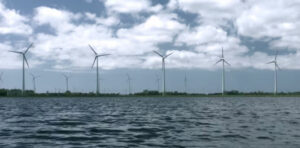THE PHILIPPINES is likely to miss its target of launching offshore wind farm operations by 2028 due to lack of progress in developing the specialized ports that will service the wind farms, the Philippine Ports Authority (PPA) said.
“Although there are 10 service contracts, I do not think all 10 could be concluded or implemented by 2028. (So far) we are looking at whether we can establish a template for the offshore wind terminals, in order to get at least one or two running by 2026 or 2027,” PPA General Manager Jay Daniel R. Santiago said.
The Department of Energy (DoE) has said the 10 concessions have a combined capacity of 6.72 gigawatts (GW).
“We are in close coordination with the DoE on the establishment of terminals to address the deployment of offshore wind equipment and facilities,” Mr. Santiago said.
The government is working with the Asian Development Bank to conduct the feasibility study for the development of 10 ports initially nominated to service the offshore industry.
“The DoE has identified at least 10 ports. At least 60% of those ports are under PPA,” Mr. Santiago said.
The feasibility study will validate whether the locations are suited as support facilities for wind farms operators.
Ports will play a crucial role in offshore wind development as their supply chains, infrastructure and other components will be transported from there to the offshore sites.
The DoE considers the offshore wind project that has made the most progress to be the one in Ilocos Norte, Mr. Santiago said, adding that if completed, that facility is expected to be the first concession to start operations.
Earlier, the Transportation department estimated that repurposing ports for offshore wind development will cost around $80 million.
The DoE has said that funding to make ports ready for the offshore wind industry needs to be budgeted for in the 2025 spending plan.
Ports that can accommodate wind power equipment are critical items in meeting the government’s timeline, according to Pedro H. Maniego, Jr., senior policy advisor at the Manila-based climate and energy policy group Institute for Climate and Sustainable Cities.
“If PPA can’t repurpose the ports in the identified offshore wind areas, it will certainly affect the target completion dates of offshore wind projects,” Mr. Maniego said via Viber.
Jose M. Layug, Jr., president of the Developers of Renewable Energy for Advancement, Inc., said the Energy department’s aggressive push for offshore wind development is subject to “many variables,” which “need to be addressed to ensure the development of offshore wind in the Philippines, including transmission and distribution infrastructure and ports,” he said via Viber message.
Mr. Layug said the Energy department could consider a pilot project of between 250 megawatts and 500 megawatts in 2028 in order to have an attainable target.
“The DoE can then announce a long-term target with a specific megawatt capacity for offshore wind from 2029 to 2034 to give the investors the proper signals about the capacity needed by the Philippines,” he said.
To date, the DoE has awarded 91 offshore wind energy service contracts with a potential capacity of 65.12 GW. — Ashley Erika O. Jose
